Modern web applications require robust full-stack development frameworks to handle complex functionalities efficiently. These frameworks provide tools and conventions that simplify the creation of robust web applications. Ruby on Rails backend development is an excellent choice for developers building scalable, high-performance apps. It offers a structured environment, which enhances productivity and reduces coding time.
Established as an expert in software outsourcing, Aloa helps businesses and startups navigate web development easily. Our expertise in programming languages, web applications, and software development ensures that we guide our clients effectively. We focus on making the development process straightforward and efficient, whether you are working with Rails developers, configuring a Rails server, or setting up a web server.
Leveraging our extensive experience, we’ve put together this guide that explores the functionality and benefits of Ruby on Rails backend development. We’ll explore how to use and set up a Rails application and understand the benefits and drawbacks of using this framework. At the end of this blog, you will learn why Ruby on Rails is an excellent choice for high-traffic web pages and how to get started with your own Rails development.
Let's dive in!
What Is Ruby on Rails Backend Development?
A Ruby on Rails backend development is a process of building server-side applications using the Ruby programming language and the Rails web application framework. It efficiently manages data, handles requests, serves dynamic content to web browsers, and integrates various components to streamline development.
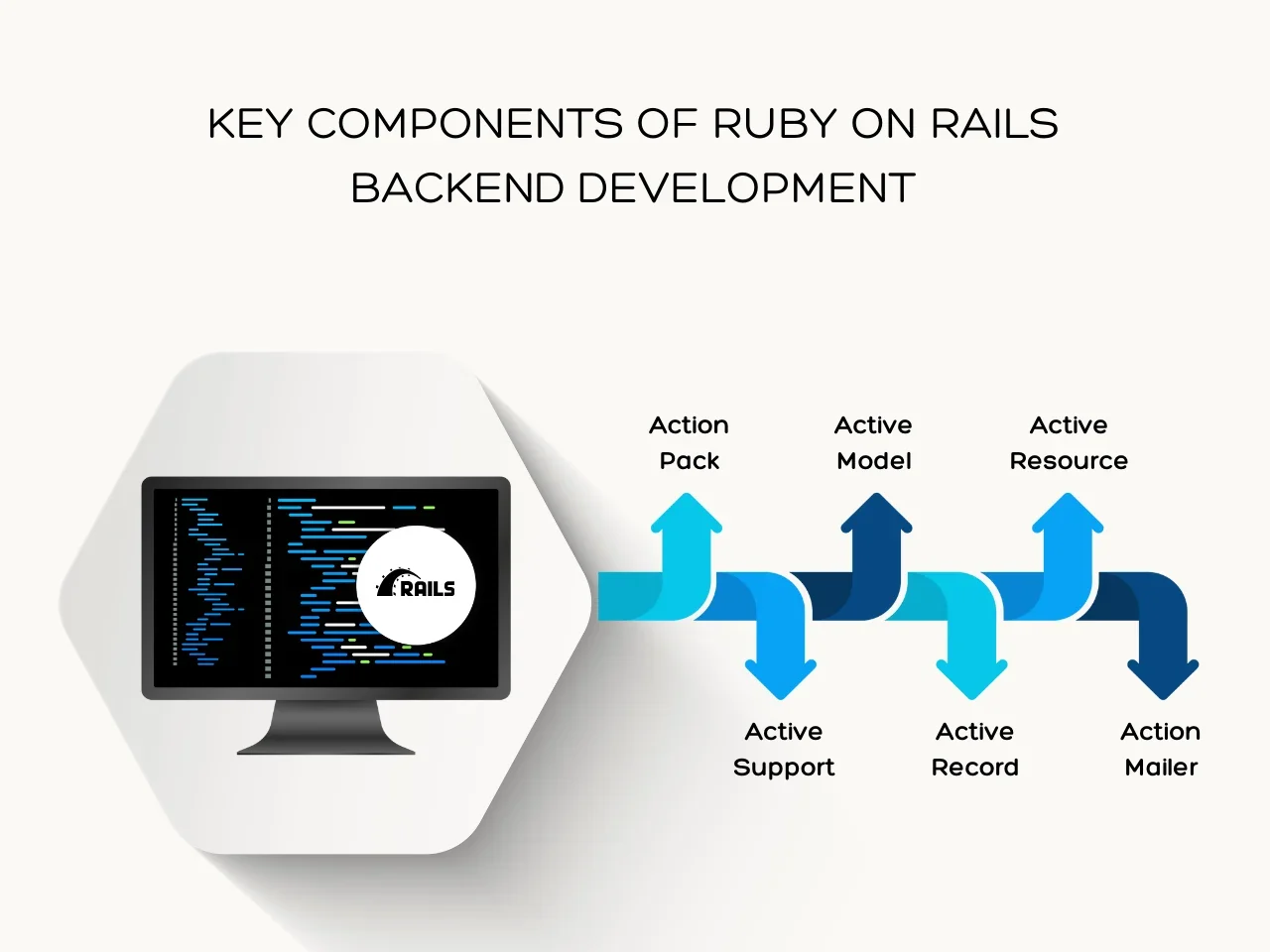
Here are the key components of Ruby on Rails backend development:
- Action Pack: Manages controllers and views, handling HTTP requests and responses. It simplifies URL routing and response rendering.
- Active Support: It provides utility classes and standard Ruby libraries. It enhances the Ruby language, offering modules that facilitate various tasks.
- Active Model: Handles the Model part of the MVC architecture and offers a standardized interface for interacting with data models.
- Active Record: Manages database interactions using ORM (Object-Relational Mapping). It simplifies database operations and migration file management.
- Active Resource: Provides an easy way to work with RESTful web services. It allows seamless integration with APIs, making data exchange efficient.
- Action Mailer: Handles email services within the application. It supports creating and sending emails, essential for many web applications.
The Ruby on Rails backend leverages these components to create robust, scalable web applications. Ruby developers find the framework's simplicity and strong community support invaluable. Its configuration and syntax make it a good choice for beginners and experienced team members.
Key Features of Ruby on Rails Backend Development
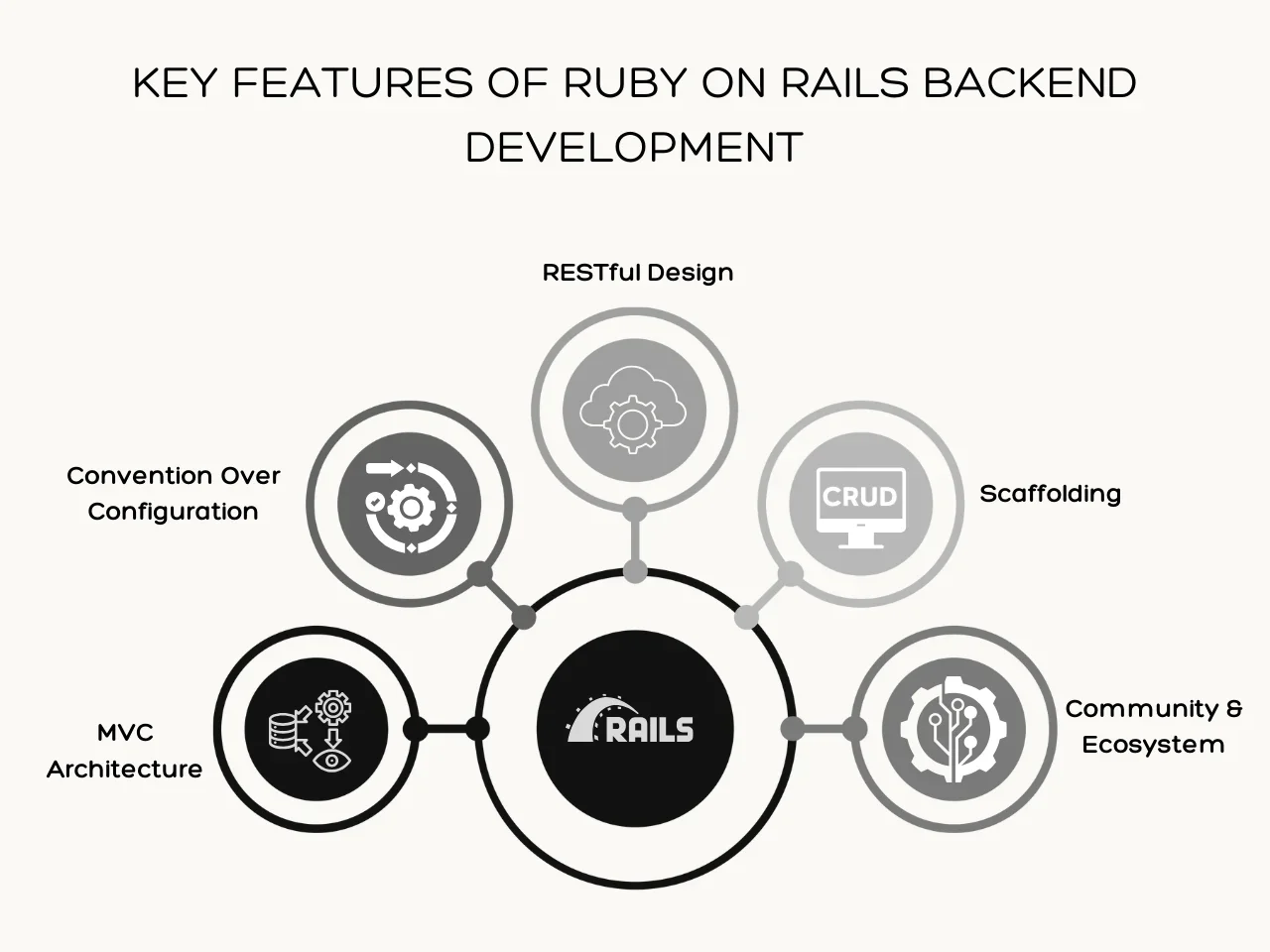
Ruby on Rails backend development simplifies and accelerates the development process. Understanding its key features can help developers and decision-makers leverage this powerful framework to build robust applications.
1. MVC Architecture
Ruby on Rails's backend follows the Model-View-Controller (MVC) architecture. This design pattern separates an application into three interconnected components. The model handles data and business logic, and the view presents data to the user. Moreover, the controller manages the application's flow. This separation makes the development process more organized and maintainable.
2. Convention Over Configuration
Convention over configuration is a core principle of Ruby on Rails backend development. The framework sets sensible defaults for various aspects of the application. Developers spend less time configuring and more time building features. This feature streamlines the development process, making it faster and more efficient.
3. RESTful Design
Ruby on Rails backend development emphasizes RESTful design principles. REST (Representational State Transfer) provides a standard way to design and interact with web services. In Ruby on Rails, RESTful routes map HTTP verbs (GET, POST, PUT, DELETE) to controller actions. This feature creates a consistent and intuitive API for the application. It also promotes best practices in web development.
4. Scaffolding
Scaffolding is a feature that accelerates the development process in Ruby on Rails backend. It automatically generates the necessary code for basic CRUD (Create, Read, Update, Delete) operations. As a result, developers can quickly build and prototype applications. Scaffolding creates controllers, views, and models based on predefined templates. This feature saves time and ensures a consistent structure in the application.
5. Community and Ecosystem
The vibrant Ruby on Rails community offers extensive resources, including gems (libraries), plugins, and tutorials. This active community support enriches the development experience, providing solutions and innovations that keep Ruby on Rails backend at the forefront of web development.
How to Use Ruby on Rails for Backend Development

Ruby on Rails (RoR) is a powerful framework for backend development known for its efficiency and developer-friendly conventions. RoR streamlines the creation of robust web applications, leveraging a wealth of built-in features. Here are five essential steps to harness RoR's capabilities effectively for backend development:
Step 1: Set Up the Environment
Setting up the environment is the first crucial step in developing a Ruby on Rails backend. Proper setup ensures smooth development and reduces potential issues later.
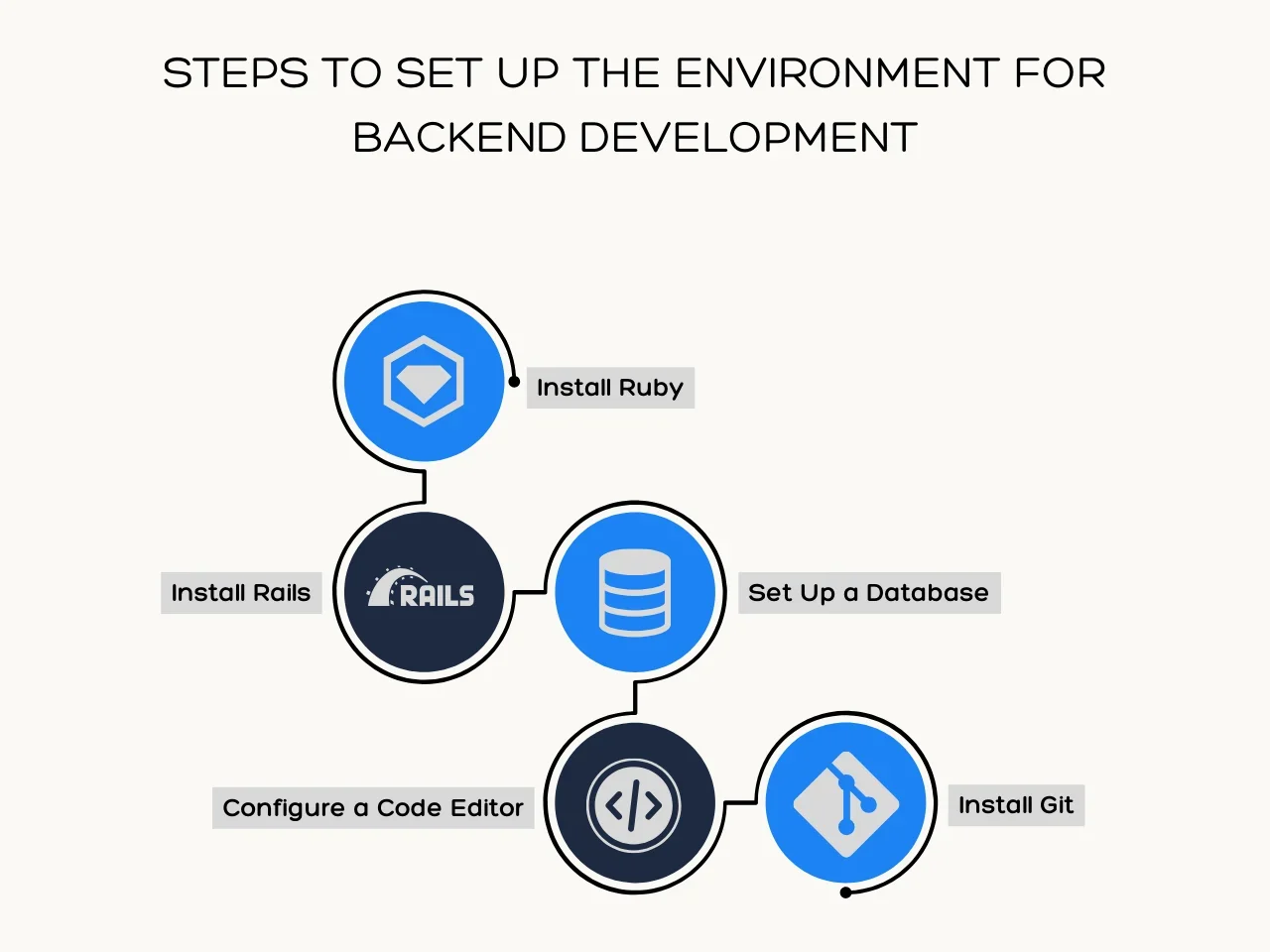
Here are the essential steps to set up the environment for backend development:
- Install Ruby: Ruby on Rails relies on the Ruby programming language. Installing the latest version of Ruby ensures compatibility and access to the latest features.
- Install Rails: Once Ruby is installed, install Rails. Use the command gem install rails to get the latest version. Rails provides the framework needed for backend development.
- Set Up a Database: Ruby on Rails works well with several databases, including SQLite, PostgreSQL, and MySQL. Choose a database and install it on your system.
- Configure a Code Editor: Select a code editor that supports Ruby on Rails. Editors like Visual Studio Code, Atom, or Sublime Text offer features that enhance development.
- Install Git: Version control is critical in backend development. Install Git to manage your codebase effectively and track changes.
Setting up these tools ensures a smooth start for backend development. Each tool plays a vital role in different stages of development. Ruby provides the language, Rails offers the framework, and the database stores your data. The code editor and Git help you write and manage your code efficiently.
Step 2: Create a New Rails Application
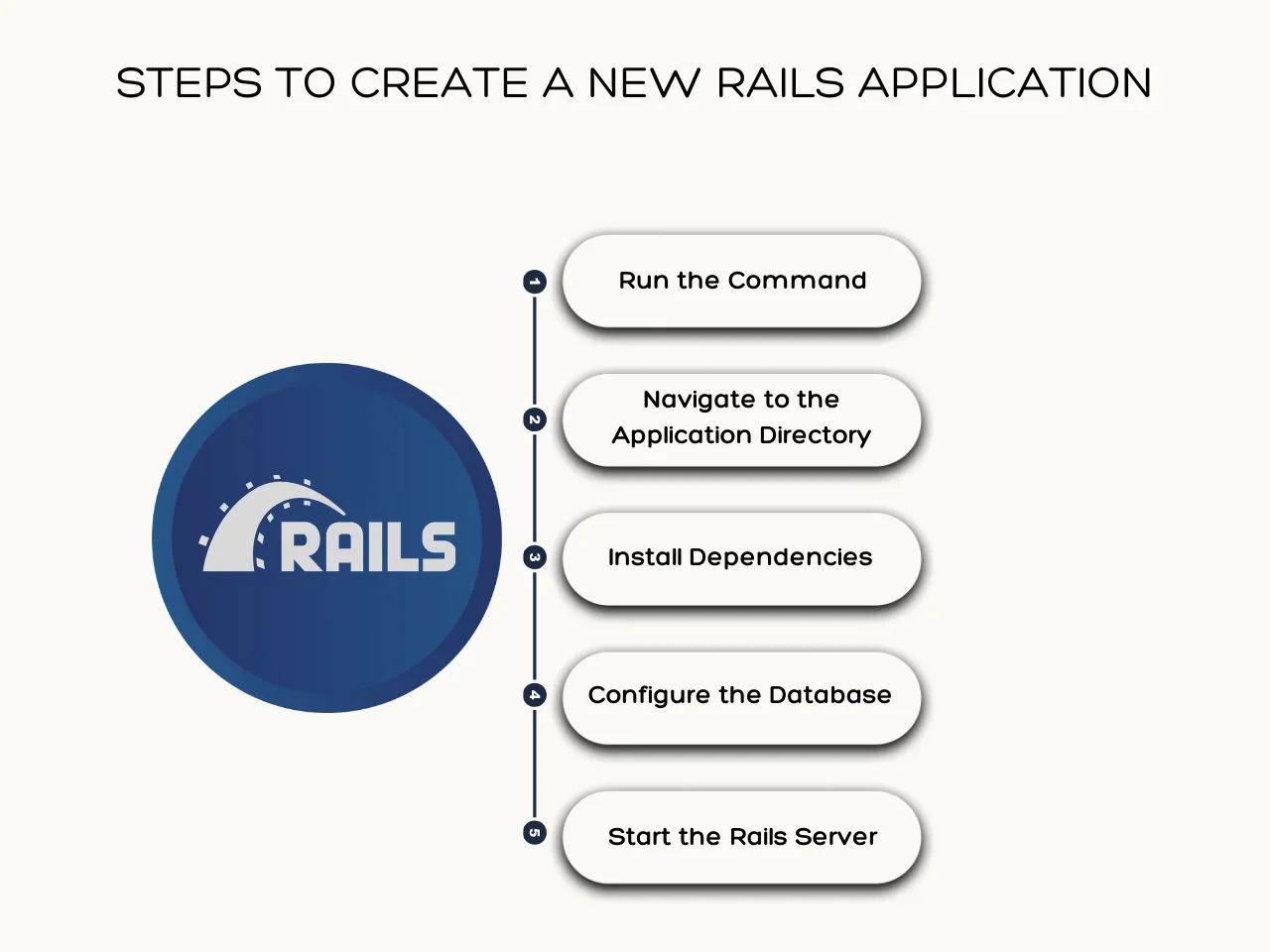
Creating a new application marks the second step in Ruby on Rails backend development. This step initiates the project structure and files needed to start coding. Here are the steps to create a new Rails application:
- Run the Command: Open your terminal and run the command rails new myapp. This command generates a new Rails application named "myapp".
- Navigate to the Application Directory: Use cd myapp to change the directory to your newly created application folder.
- Install Dependencies: Run bundle install to install all the gems and dependencies listed in the Gemfile.
- Configure the Database: Open the config/database.yml file to configure your database settings. Ensure it matches the database you set up in the environment.
- Start the Rails Server: Use rails server or rails s to start the Rails server. Access your new application through http://localhost:3000 in a web browser.
Creating a new Rails application involves initializing and setting up the project's structure, where the rails new command lays the foundation. Navigate to the application directory and install dependencies to ensure all required components are in place. Configuring the database correctly aligns your application with your setup.
Starting the Rails server confirms that your application runs appropriately. This step completes the initial setup, allowing you to move forward with developing your Ruby on Rails. Each step ensures your application has the necessary components, paving the way for further development.
Step 3: Build the Database
Building the database forms a crucial step in Ruby on Rails backend development. This process involves configuring the database, creating models, and generating migrations. Choose a suitable database management system that integrates seamlessly with Ruby on Rails, such as PostgreSQL or MySQL.
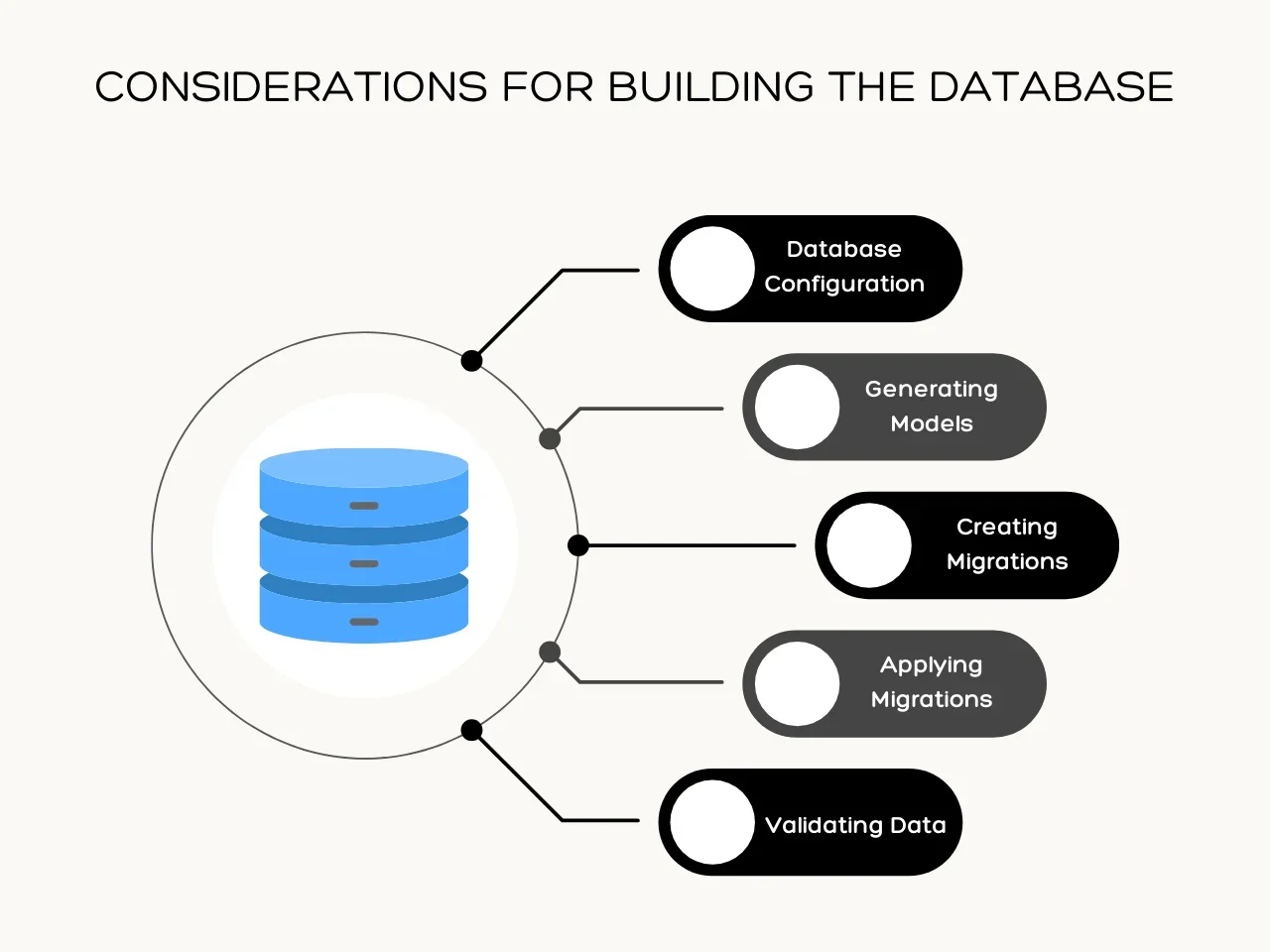
Here are the key considerations for building the database:
- Database Configuration: Configure your database settings in the config/database.yml file. Specify the adapter, database name, username, and password. Ensure secure configurations to protect sensitive information.
- Generating Models: Use the rails generate model command to create models. This command also generates the associated migration files. Models represent your application's data structure and business logic.
- Creating Migrations: Migrations are Ruby scripts that modify the database schema. Run rails generate migration to create migration files. These files define changes like creating tables, adding columns, or deleting fields.
- Applying Migrations: Apply migrations using the rails db:migrate command. This command updates the database schema based on the migration files. Always check for errors and ensure the database structure meets the application requirements.
- Validating Data: Implement validations in your models to ensure data integrity. Use built-in Rails and validation helpers, like validates_presence_of and validates_uniqueness_of to enforce data rules.
Efficient database building ensures the backend operates smoothly. Proper configuration and migration management prevent future issues. Validate data to maintain integrity and prevent corrupted entries.
Step 4: Develop the Application Logic
Developing the application logic in Ruby on Rails involves creating controllers, views, and handling routes. This step is crucial for building the core functionality of your application. The Ruby on Rails backend framework simplifies these tasks, allowing developers to focus on writing clean and efficient code.
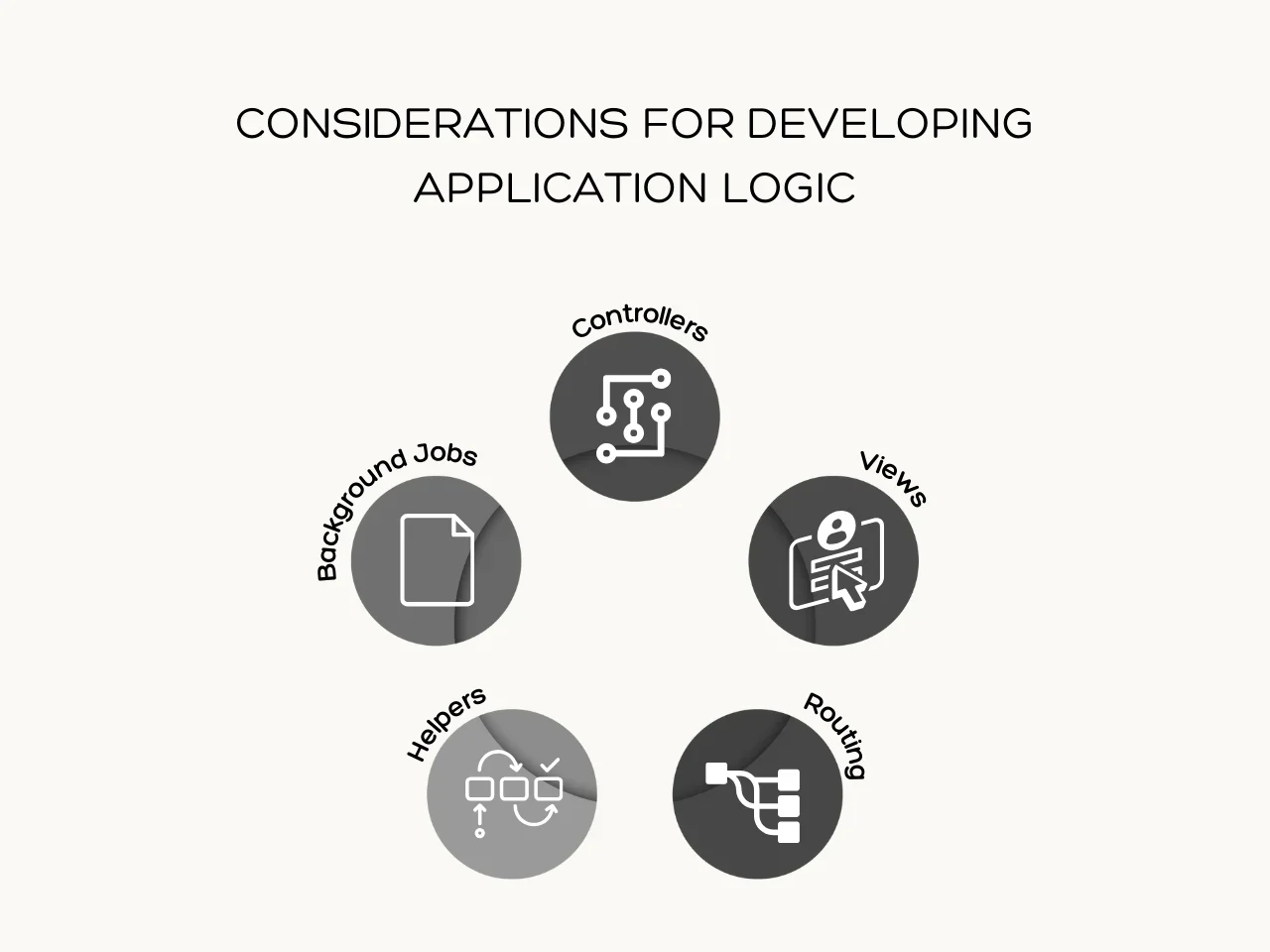
Here are the key considerations for developing application logic:
- Controllers: Controllers manage the flow of data between the model and view. Use them to define actions for handling user requests.
- Views: Views render the user interface. Keep them simple and avoid embedding too much logic.
- Routing: Set up routes to connect URLs with controller actions. Ensure routes are RESTful to maintain consistency.
- Helpers: Use helper methods to keep your views clean. Helpers modularize reusable code snippets.
- Background Jobs: For time-consuming tasks, use background jobs to keep the application responsive.
When developing your backend, always follow the MVC pattern. This structure helps maintain a clean separation of concerns. Use RESTful routes to ensure your application adheres to standard practices. You may also incorporate helpers to streamline your views. Finally, leverage background jobs to handle intensive processes efficiently.
Step 5: Test and Debug
Testing ensures your Ruby on Rails backend works correctly. Start by writing tests for your models, controllers, and views. Built-in tools like RSpec and Minitest can be used to create automated tests, which help identify issues early. Create unit tests to check individual components and integration tests to verify how components work together. Regularly run these tests to catch and fix bugs before deploying your application.
Debugging involves identifying and fixing errors in your Ruby on Rails backend. Use tools like Pry and Byebug to step through code and inspect variables. Reproduce bugs in a development environment to understand their cause. Fix bugs systematically and retest to ensure the issues are resolved. Regular testing and debugging keep your Ruby on Rails backend robust and reliable.
Pros and Cons of Using RoR for Backend Development
Ruby on Rails (RoR) Backend development offers a dynamic and efficient way to build web applications. Understanding its advantages and disadvantages helps developers and businesses decide if RoR suits their needs.
Pros of Using Ruby on Rails for Backend Development

Ruby on Rails backend development stands out among backend frameworks for several reasons. Here are the top five benefits:
- Rapid Development: RoR allows quick development due to its default configurations and conventions. This reduces the time needed to build and launch applications, making it the best way to develop web applications swiftly.
- Strong Rails Community: The Rails community provides extensive support and resources. Programmers can access countless tutorials, gems, and forums.
- Comprehensive Documentation: RoR’s documentation is thorough and well-organized. Whether new or with prior experience, developers can easily find the information they need. Its ease of access further makes RoR an attractive choice for many projects.
- Built-In Testing: RoR includes built-in testing tools, enabling developers to write tests for their applications seamlessly. This feature ensures code reliability and reduces bugs.
- Flexibility and Scalability: RoR offers flexibility, allowing for easy adjustments as projects evolve. Its scalable nature supports the growth of applications, from small startups to large enterprises like Airbnb and Netflix.
Cons of Using Ruby on Rails for Backend Development
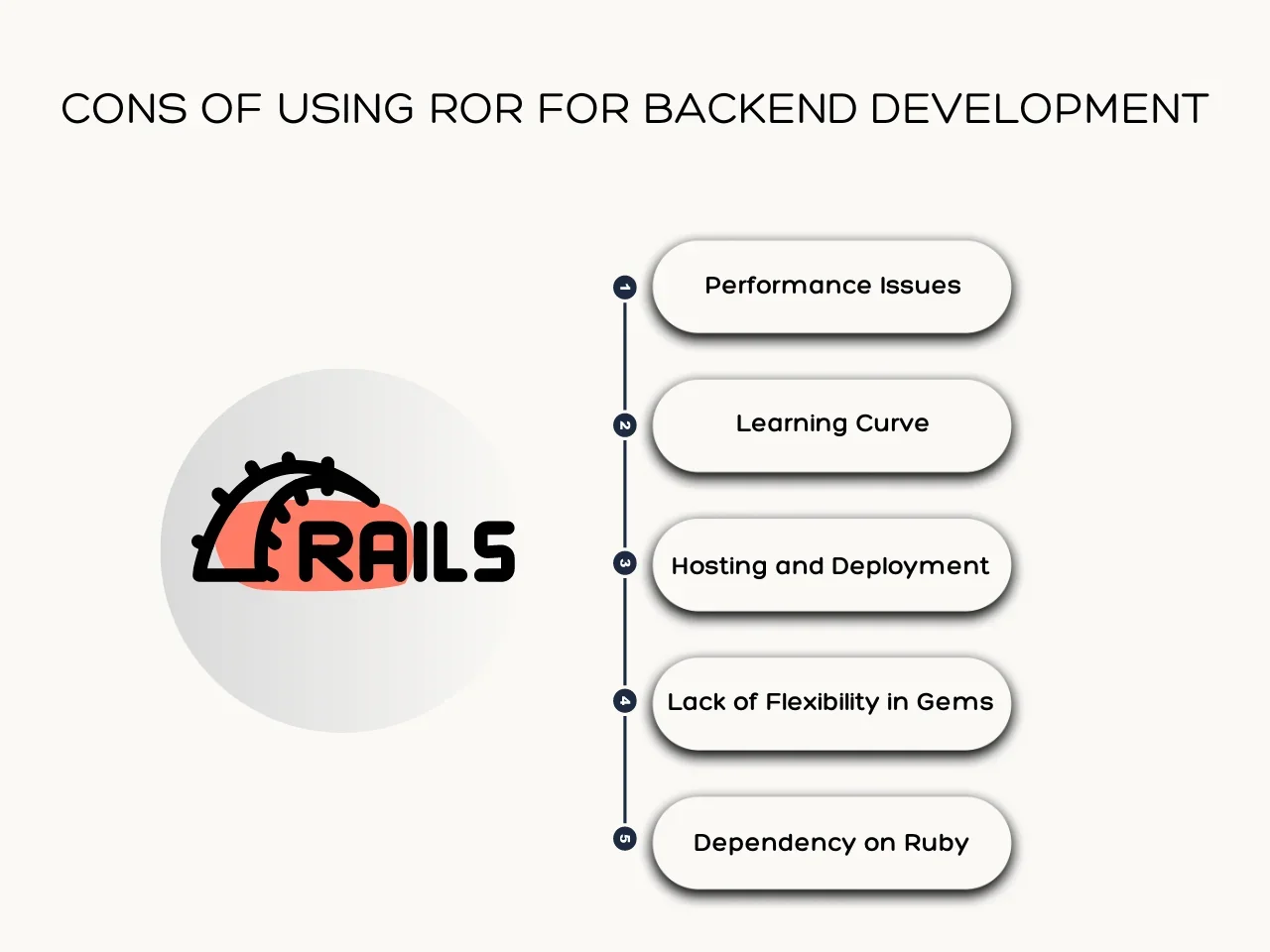
While Ruby on Rails backend development has many advantages, it also caters to some drawbacks. Here are the top five cons:
- Performance Issues: RoR may encounter performance challenges, especially with large-scale applications. Its speed might not match other backend frameworks like Python’s Django or Java.
- Learning Curve: RoR’s conventions and syntax may pose a learning curve for developers without prior experience. Transitioning from other web frameworks, such as PHP or JavaScript, can take time and effort.
- Hosting and Deployment: RoR requires specific server configurations, complicating the hosting and deployment process. This factor might make RoR less appealing than a more universally compatible web framework.
- Lack of Flexibility in Gems: While gems offer much functionality, some might need more flexibility for specific projects. This limitation can restrict the customization options available to developers.
- Dependency on Ruby: RoR's reliance on Ruby can be a disadvantage for teams familiar with other languages like Java or Python. This dependency might necessitate additional training or the hiring of specialized programmers.
Key Takeaway
Ruby on Rails backend offers numerous benefits for web development projects. Its efficiency and speed make it an ideal choice for startups and businesses. The framework provides a solid structure, helping Ruby on Rails developers create applications quickly and effectively. With robust community support, it ensures that any challenges get resolved swiftly, allowing developers to maintain momentum and deliver high-quality applications.
Consider the flexibility and scalability of Ruby on Rails backend when choosing a framework. Its convention over the configuration approach streamlines development, reducing the time spent on setup and configuration. This means developers can focus more on writing code and implementing features. Additionally, built-in testing tools help ensure applications remain stable and secure throughout development.
Ready to hire a Ruby on Rails web developer for your project? Aloa has the expertise and experience to help you harness the full potential of Ruby on Rails backend development. Explore the Aloa blogs for more insights and tips on backend development.

